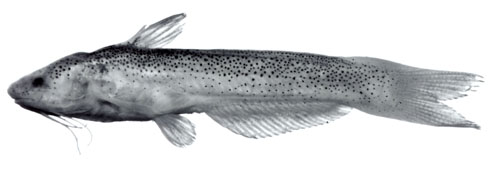
Photo by Britt Griswold
Reproduced from Vari, Ferraris and de Pinna (2005).
Cetopsidium Vari, Ferraris & de Pinna, 2005
The combination of the presence of a dorsal fin with an ossified spinelet and the presence of pectoral- and dorsal-fin spines distinguishes the species of Cetopsidium from all other genera in the Cetopsinae. The possession of a lateral line extending to over the posterior portion of the base of the anal fin but falling short of the caudal peduncle is also unique to Cetopsidium within the Cetopsinae. The other genera within the Cetopsinae either have a shorter lateral line that is restricted to the abdominal portion of the body (Denticetopsis royeroi and D. sauli) or have a longer lateral line extending posteriorly at least onto the posterior portion of the caudal peduncle (all members of the Cetopsinae with the exception of Denticetopsis royeroi and D. sauli and the species of Cetopsidium). Cetopsidium is further distinguished from Denticetopsis by having the mental barbels extending posteriorly beyond the rear margin of the opercle versus falling short of that point, respectively, and in having a deeply-forked caudal-fin margin in contrast to an emarginate or obliquely-truncate caudal-fin margin, respectively.
KEY TO THE SPECIES OF CETOPSIDIUM
| 1. | Tip of adpressed pelvic fin extending beyond vent and reaching to origin of anal fin | Cetopsidium minutum |
| Tip of adpressed pelvic fin falling short of, or reaching, vent but always falling short of origin of anal fin | ||
| 2. | Vent located distinctly anterior to base of anterior most anal-fin ray | Cetopsidium roae |
| Vent located proximate to base of anterior most anal-fin ray | ||
| 3. | Dark pigmentation on body limited to middorsal region; distal filaments on first rays of dorsal and pectoral fins absent | Cetopsidium ferreirai |
| Dark pigmentation on body distributed over all of dorsal and lateral surfaces; distal filaments present on first rays of dorsal and pectoral fins of mature males | ||
| 4. | Ventral surface of lower jaw with broad band of dark chromatophores; dorsal and ventral portions of postdorsal region of body running in parallel | Cetopsidium orientale |
| Ventral surface of lower jaw with single or incomplete row of dark chromatophores; dorsal and ventral portions of postdorsal region of body converging posteriorly | ||
| 5. | Dorsal and lateral surfaces of body with uniformly-distributed, dark chromatophores; dark chromatophores typically small and round | Cetopsidium pemon |
| Dorsal and lateral surfaces of body with dark chromatophores concentrated dorsally; dark chromatophores large and stellate | Cetopsidium morenoi |